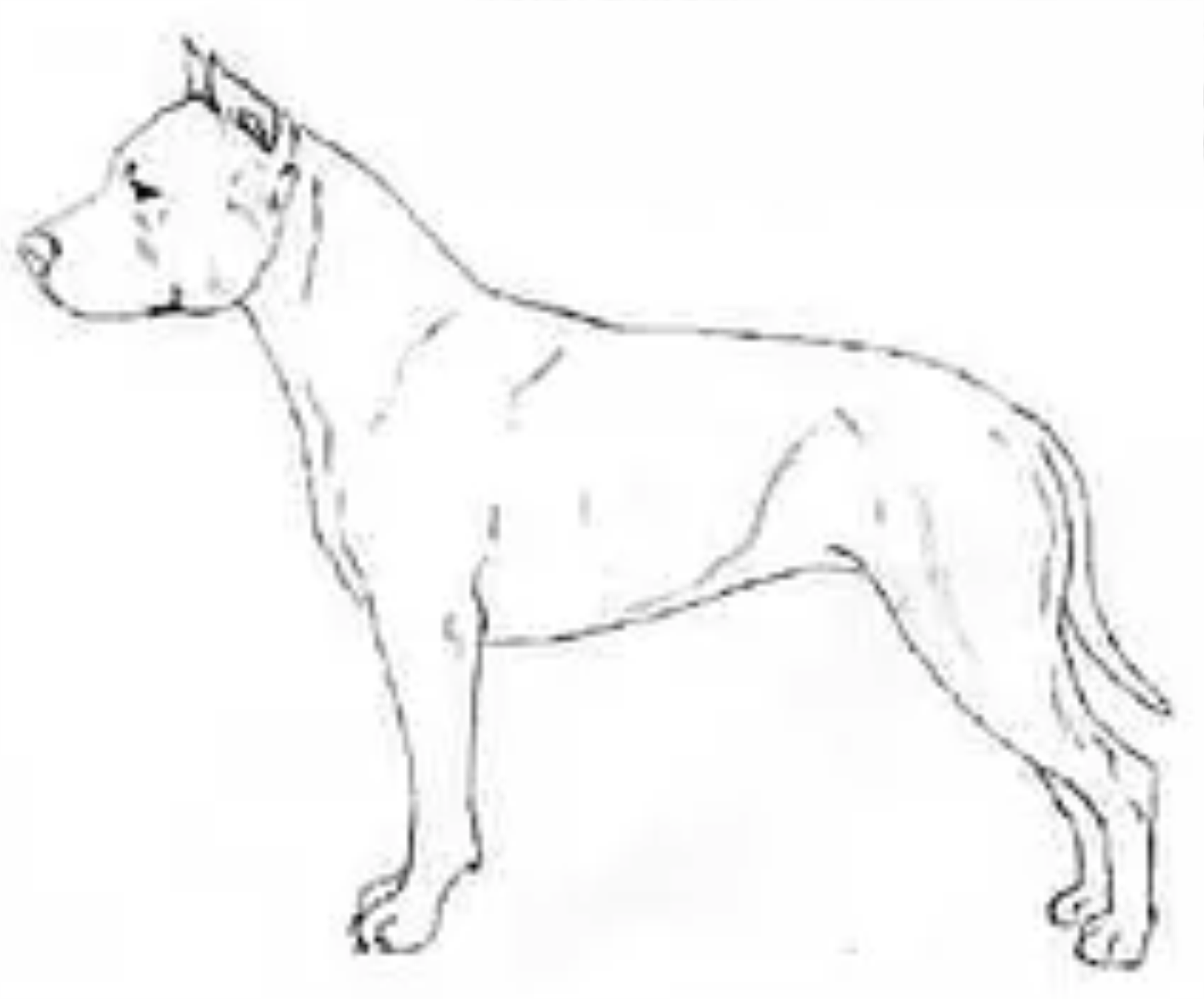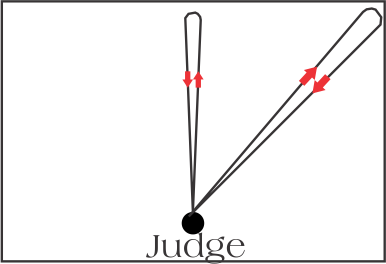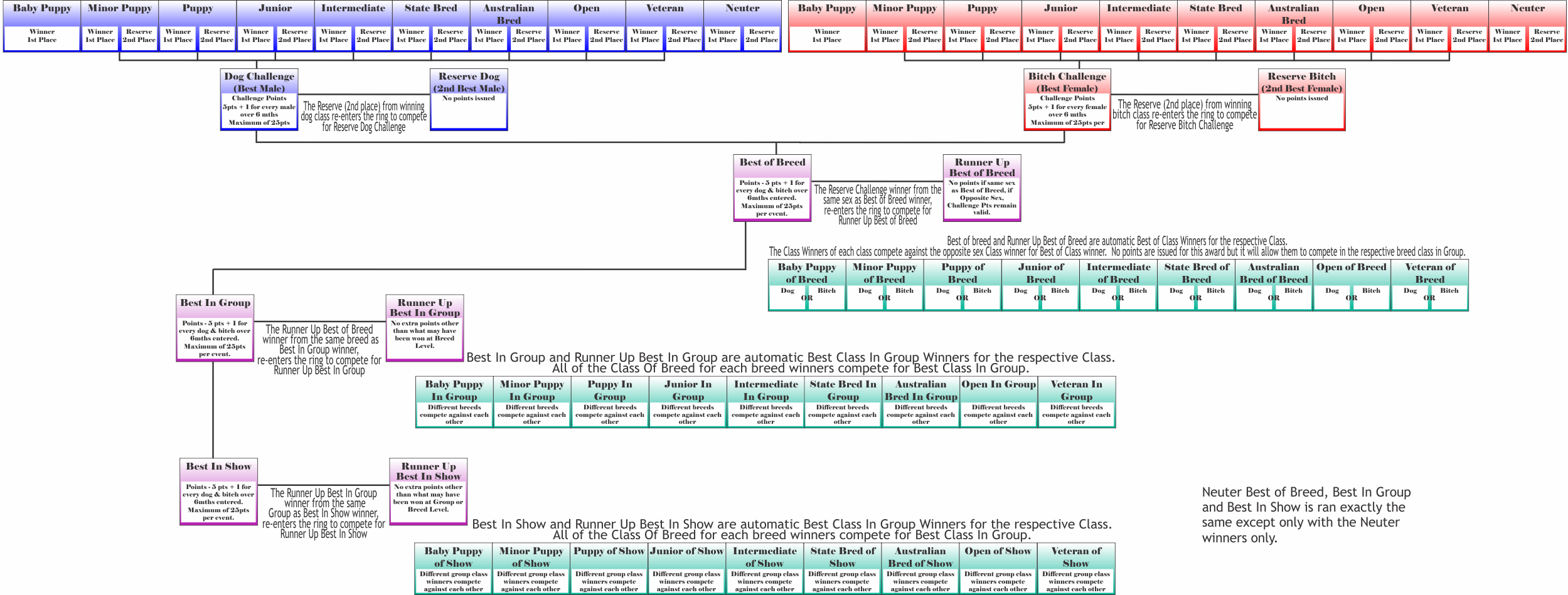|
Why Show Dogs?
Every Purebred dog in the world has a Breed Standard, the guidelines which describe the ideal characteristics, temperament, and appearance of a breed and ensures that the breed is fit for function with soundness essential.
The first dog show to compare and evaluate dog breeding stock was held in 1859 in England. Later on the Kennel Club was formed to register dogs, record data and create guidelines. Fanciers in the United States quickly followed and created the American Kennel Club in 1884. The Australian National Kennel Council was formed in 1958.
Breed standards were written to describe the different breeds, their physical characteristics, movement and their temperaments, which allowed them to perform their jobs to the fullest. These standards would be used to evaluate future breeding stock. Winners at shows would be the best specimens of the breed used for breeding future working dogs.
Our dogs today generally do not work, they are simply our companions, but their breed histories still influence the breed standards. At today’s dog shows, each dog is compared with its breed standard in order to see if that dog could perform its intended job if needed. The breed standard is written by the breed club and often contains information about the dog’s general appearance, temperament, head, neck, forequarters, body, hindquarters, feet, coat, color, size, gait and any serious faults or disqualifications. Although they may be revised, the breed standards of today must still be based on the breed history and purpose, and dogs should still be bred so that they can perform the tasks their ancestors were bred to do.
In the conformation ring, dog show judges must decide which dog is the best of the best, and they see how each dog lives up to its written breed standard; they compare the dog to the ideal dog depicted in the breed standard. The dog that is awarded is the dog with the most of the best qualities, it is the dog that most closely resembles its breed standard.
|
|
Who is the Australian National Kennel Council (ANKC)?
The Australian National Kennel Council Ltd (ANKC Ltd) is the peak body in Australia responsible for promoting breeding, showing, trialling, obedience, and other canine-related activities and the ownership of temperamentally and physically sound purebred dogs by individuals across Australia.
|
State Bodies
In Australia each state has a State Body that is part of the ANKC.
* Dogs QLD
* Dogs NSW
* Dogs VIC
* Dogs TAS
* Dogs SA
* Dogs West
* Dogs NT
Contact the Body in your State to become a Member.
|
How do I get involved?
* Join up with your State Body as a Member and you will receive information monthly regarding the shows that are being held throughout that state.
* Ensure that your dog has Main Register (please see FAQ regarding Registers) ANKC Pedigree Papers.
* There are Show Training days held by Clubs, these are a good start for your and your dog.
* The breeder of your dog should be able to help point you in the right direction for showing.
* Minimal equipment is required to start!
|
|
Frequently asked questions!
Where are shows held? Dog Shows are held all over each state, in QLD a lot are held at the DogsQLD Showgrounds or Dog Club grounds. There is likely a Dog Show held very close to your home.
What are the different registers? Each breeder has the option to register their puppies on the Main or Limited Register, in short, Main Register is for Showing, Sporting & Breeding, Limited is for Sporting or Pet.
My dog has absolutely no manners at all. That’s ok, there are Show Training days held by Clubs throughout QLD, or go along to a show and speak to competitors and enlist their help with training.
How do I know if my dog is show quality? This is one of the purposes of Conformation Showing, however whether your dog wins or loses, you are still taking home the best dog because they are yours. Conformation Shows are a fun day out with your family and people with the same passion.
|
|
What are the Breed Groups?
Group 1 ~ Toys
Group 2 ~ Terriers
Group 3 ~ Gundogs
Group 4 ~ Hounds
Group 5 ~ Working Dogs
Group 6 ~ Utility
Group 7 ~ Non Sporting
|
Types of Shows
Championship Show ~ Points awarded towards Titles
Open Show ~ No Points awarded, judged by trainee judges
Parade ~ Same as Open Show but no Champions can compete.
|
What equipment do I need?
* A check chain and lead
* A chair
* Water and bowls
* A crate if you have one
* Shade for you and your dog
* Comfortable clothes and enclosed footwear
|
|
What are the Classes?
Class 1 ~ Baby Puppy ~ For dogs aged three and under six months.
Class 2 ~ Minor Puppy ~ For dogs aged six and under nine months.
Class 3 ~ Puppy ~ For dogs aged six and under twelve months.
Class 4 ~ Junior ~ For dogs aged nine and under eighteen months.
Class 5 ~ Intermediate ~ For dogs aged eighteen and under thirty-six months.
Class 9 ~ State Bred ~ For dogs six months of age or over bred in the State or Territory in which they are exhibited.
Class 10 ~ Australian Bred ~ For dogs aged six months or over bred in Australia.
Class 11 ~ Open ~ For dogs aged six months or over and of a breed or variety recognised by the ANKC Ltd.
Class 18 ~ Open Neuter ~ For neuter dogs aged six months or over.
Males are entered via their respective class number, Female numbers have a ‘a’ behind them.
There are many more classes that may be held, however the ones listed above are the most common.
|
|
Entering Your First Show
There are two ways to enter, fill in a entry form and post or enter via on a online entry provider.
When you have read the schedule you will note a number of important features of the show are quoted:
~ the date of the fixture and location of where the show is being held
~ the type of show, championship show, open show or competition
~ the judge or judges officiating
~ the name and address of the Kennel Club Secretary to whom the entries should be sent if not entering online
~ the closing date of entry
~ the classes offered for the breeds
These details and your dog’s pedigree papers (Refer back to our pedigree papers explained page if need be) will be required to enter a show, all the information required is on your dogs papers. Fill in the information required, select the class you wish to enter and enclose payment. Once you have paid for your entry, you are now entered. Please ask for help if you need it!!
|
|
The Day of Your First Show!
Make sure you arrive early, at least a hour prior to the start time is good, to allow you to collect your numbers, toilet your dog, and relax.
Make sure your dog is clean, groomed if required and you are ready for the start.
Breeds are exhibited in alphabetical order, males first, then females, then a run off between the best male and female for Best of Breed. (more is explained in the flowsheet)
Your number will be called 3 times, if you have not arrived at the ring entrance by the 3rd call, you will be marked absent and will not be allowed to show your dog.
Watch what is happening in the ring prior to going in yourself, what the judge is asking the competitors to do.
Advise the ring steward you are new, they will help you in regard to what is required.
|
|
Entering the ring!
Each judge is different, this is where watching prior to entering is important to give you a idea of what will be required.
You may be required to do a circle then stack infront of the table, or to just stack infront of the table. Stacking your dog can be different in each breed, but majority require your dog to be side on to the judge, front legs in line and rear legs in line, the rear hocks should be at a 90 degree angle to the ground.

The judge will then examine your dog, starting at the mouth, he will look at your dogs bite and teeth, then their head, eyes and ears, down the body to the tail where he will examine if your male dog has two testicles. After the examination, the judge will ask you to either complete a Triangle, Circle or Up and Back as illustrated below.
Upon completion of this workout, the judge will place you in order of what his decision is. If you win first place do not leave the assembly area as you will be required to take your place in the Challenge line up, (line up to award the best male or best female of each breed). In the Challenge lineup, follow the judge’s direction, maintaining a good distance from the dog in front of you.
If you win Challenge or Reserve Challenge, again do not leave the assembly area as you will be required to compete for Best of Breed or Runner Up Best of Breed.
All male and female class winners are then required to compete for class of breed awards, keep a ear out for your number at all times.
If you have won a class at any stage, do not leave the grounds, you will be required to compete in the group awards once all the breeds in your group have been judged.
Please see the flowchart to follow the order awards happen.
|
|
The Triangle
Starting at the judge, go to the furtherest corner, across the back of the ring and then diagonally back to the judge!

|
The Circle
Starting at the judge, utilise the entire ring to complete a circle, finishing infront of the judge.

|
The Up and Back
Starting at the judge, either go to the back rope and return or the corner and return to the judge.

|
|
Australian Conformation Titles
At each show, the best male and best female of each breed is awarded Challenge points, 5 for competing and 1 point for each dog in their respective sex entered over the age of 6 months.
The winner of Best of Breed loses their challenge points, but receives 5 points for competing and 1 point for every dog of that breed entered over the age of 6 months. The maximum points issued to a dog at any one show is 25 points.
CHAMPION
A Champion title is awarded to any dog that has obtained 100 points.
NEUTER CHAMPION
A Neuter Champion title is awarded to any neutered dog that has obtained 100 points.
GRAND CHAMPION
A Grand Champion title is awarded to any dog that has obtained 1000 points.
SUPREME CHAMPION
A Supreme Champion title is awarded to any dog that has obtained 1000 points and 3 All Breeds Best in Shows; or 10 Best in Group/MultiBreed or Breed Specialty Best in Show. Either 3 different Best in Show Judges or 10 different Best in Group/Specialty judges must be submitted, there can be no repeated judges.
|
 |















